INF60010 - Agile System Development Approach: Modeling & Documentation
VerifiedAdded on 2023/06/11
|5
|1350
|323
Essay
AI Summary
This essay critically examines the statement that the agile system development approach is simple and doesn't require modeling and documentation, arguing against this notion using the Virtual Child International (VCI) case study as an example. It highlights the importance of clear documentation and modeling for user understanding, especially for complex systems like VCI, which involves terms and conditions, payment processes, and user interfaces. The essay emphasizes that proper modeling, including domain models and user interface prototypes, is essential for creating user-friendly systems. It concludes that system modeling and documentation are crucial components of system development, ensuring a positive user experience and effective communication, especially in systems involving payments and sensitive user data. Desklib offers a wide range of study resources, including solved assignments and past papers, to aid students in their academic endeavors.
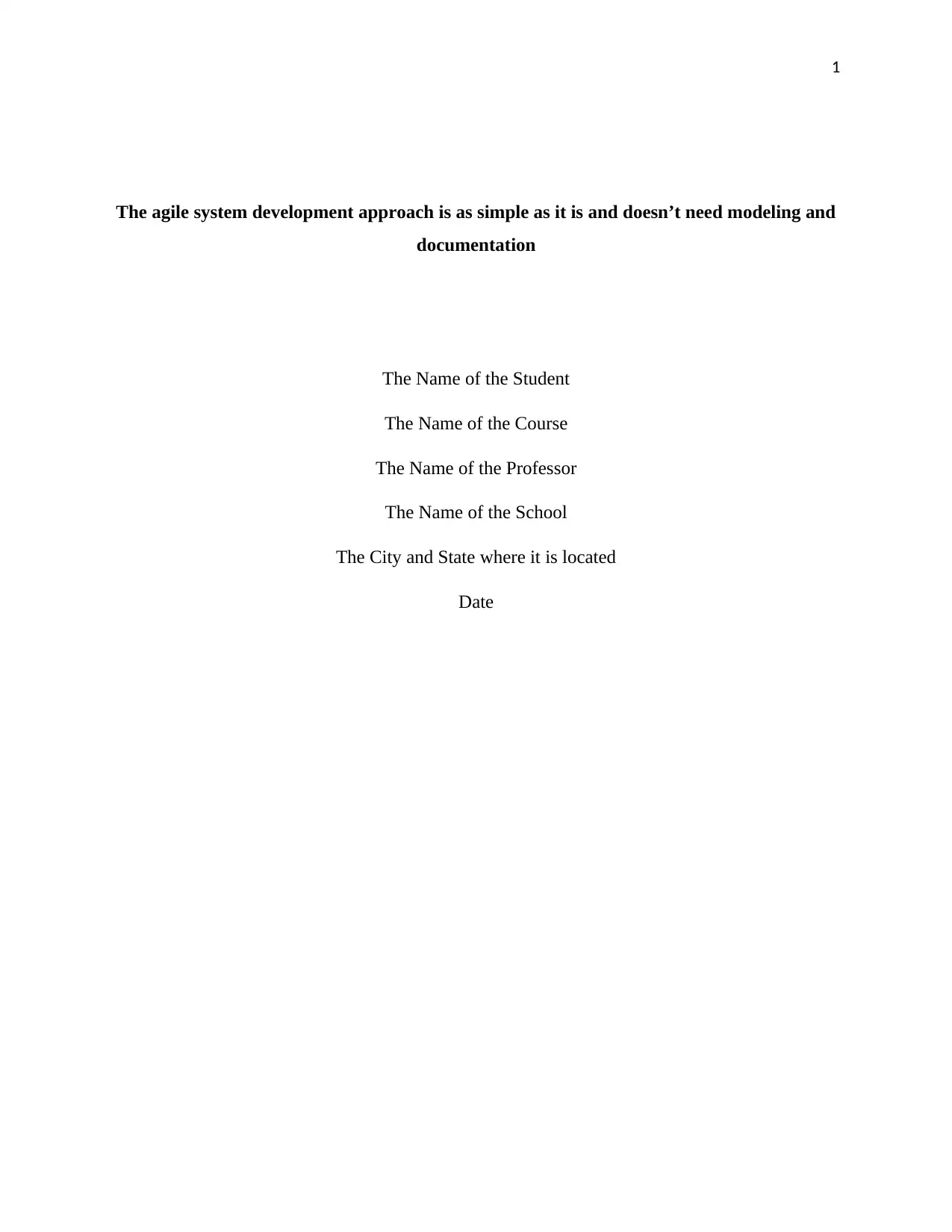
1
The agile system development approach is as simple as it is and doesn’t need modeling and
documentation
The Name of the Student
The Name of the Course
The Name of the Professor
The Name of the School
The City and State where it is located
Date
The agile system development approach is as simple as it is and doesn’t need modeling and
documentation
The Name of the Student
The Name of the Course
The Name of the Professor
The Name of the School
The City and State where it is located
Date
Paraphrase This Document
Need a fresh take? Get an instant paraphrase of this document with our AI Paraphraser
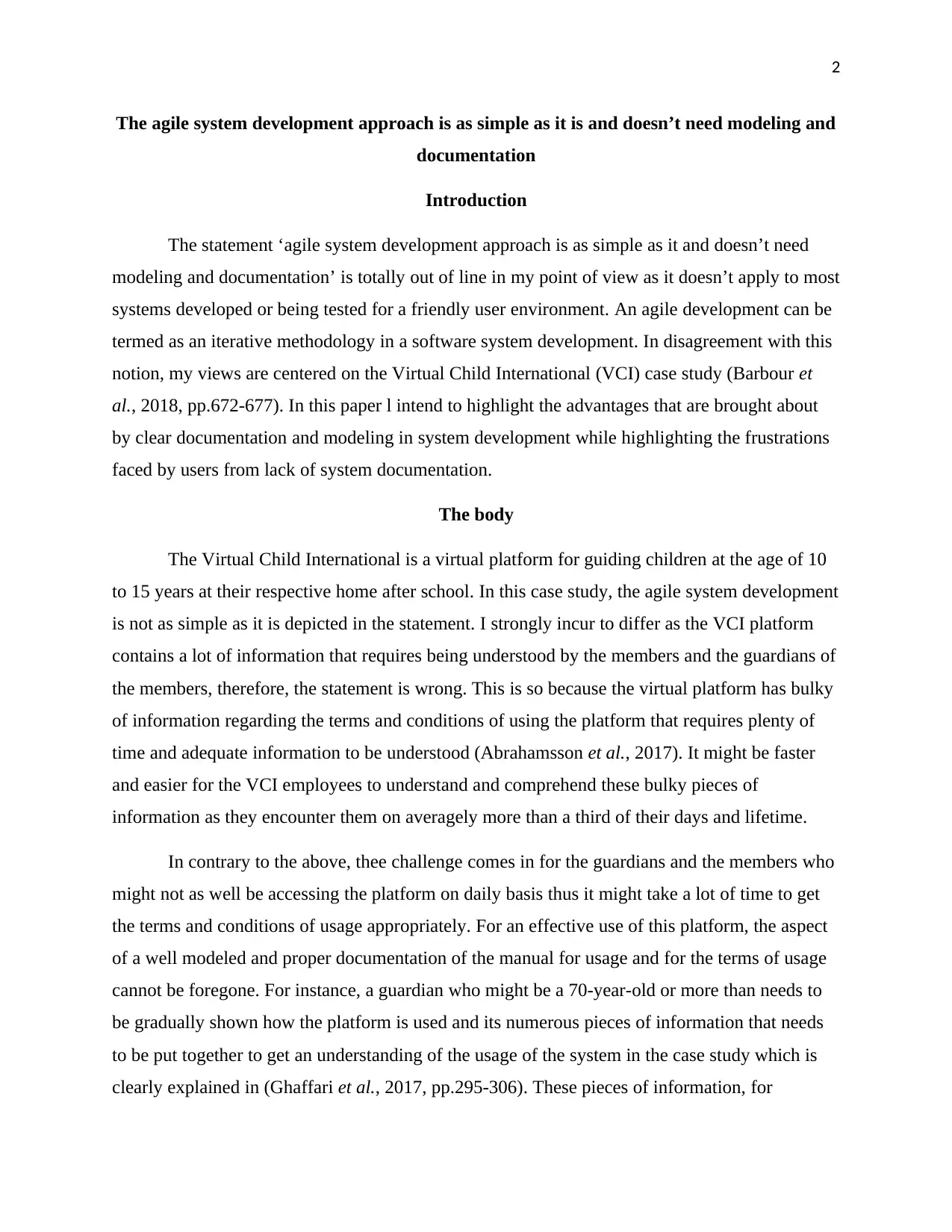
2
The agile system development approach is as simple as it is and doesn’t need modeling and
documentation
Introduction
The statement ‘agile system development approach is as simple as it and doesn’t need
modeling and documentation’ is totally out of line in my point of view as it doesn’t apply to most
systems developed or being tested for a friendly user environment. An agile development can be
termed as an iterative methodology in a software system development. In disagreement with this
notion, my views are centered on the Virtual Child International (VCI) case study (Barbour et
al., 2018, pp.672-677). In this paper l intend to highlight the advantages that are brought about
by clear documentation and modeling in system development while highlighting the frustrations
faced by users from lack of system documentation.
The body
The Virtual Child International is a virtual platform for guiding children at the age of 10
to 15 years at their respective home after school. In this case study, the agile system development
is not as simple as it is depicted in the statement. I strongly incur to differ as the VCI platform
contains a lot of information that requires being understood by the members and the guardians of
the members, therefore, the statement is wrong. This is so because the virtual platform has bulky
of information regarding the terms and conditions of using the platform that requires plenty of
time and adequate information to be understood (Abrahamsson et al., 2017). It might be faster
and easier for the VCI employees to understand and comprehend these bulky pieces of
information as they encounter them on averagely more than a third of their days and lifetime.
In contrary to the above, thee challenge comes in for the guardians and the members who
might not as well be accessing the platform on daily basis thus it might take a lot of time to get
the terms and conditions of usage appropriately. For an effective use of this platform, the aspect
of a well modeled and proper documentation of the manual for usage and for the terms of usage
cannot be foregone. For instance, a guardian who might be a 70-year-old or more than needs to
be gradually shown how the platform is used and its numerous pieces of information that needs
to be put together to get an understanding of the usage of the system in the case study which is
clearly explained in (Ghaffari et al., 2017, pp.295-306). These pieces of information, for
The agile system development approach is as simple as it is and doesn’t need modeling and
documentation
Introduction
The statement ‘agile system development approach is as simple as it and doesn’t need
modeling and documentation’ is totally out of line in my point of view as it doesn’t apply to most
systems developed or being tested for a friendly user environment. An agile development can be
termed as an iterative methodology in a software system development. In disagreement with this
notion, my views are centered on the Virtual Child International (VCI) case study (Barbour et
al., 2018, pp.672-677). In this paper l intend to highlight the advantages that are brought about
by clear documentation and modeling in system development while highlighting the frustrations
faced by users from lack of system documentation.
The body
The Virtual Child International is a virtual platform for guiding children at the age of 10
to 15 years at their respective home after school. In this case study, the agile system development
is not as simple as it is depicted in the statement. I strongly incur to differ as the VCI platform
contains a lot of information that requires being understood by the members and the guardians of
the members, therefore, the statement is wrong. This is so because the virtual platform has bulky
of information regarding the terms and conditions of using the platform that requires plenty of
time and adequate information to be understood (Abrahamsson et al., 2017). It might be faster
and easier for the VCI employees to understand and comprehend these bulky pieces of
information as they encounter them on averagely more than a third of their days and lifetime.
In contrary to the above, thee challenge comes in for the guardians and the members who
might not as well be accessing the platform on daily basis thus it might take a lot of time to get
the terms and conditions of usage appropriately. For an effective use of this platform, the aspect
of a well modeled and proper documentation of the manual for usage and for the terms of usage
cannot be foregone. For instance, a guardian who might be a 70-year-old or more than needs to
be gradually shown how the platform is used and its numerous pieces of information that needs
to be put together to get an understanding of the usage of the system in the case study which is
clearly explained in (Ghaffari et al., 2017, pp.295-306). These pieces of information, for
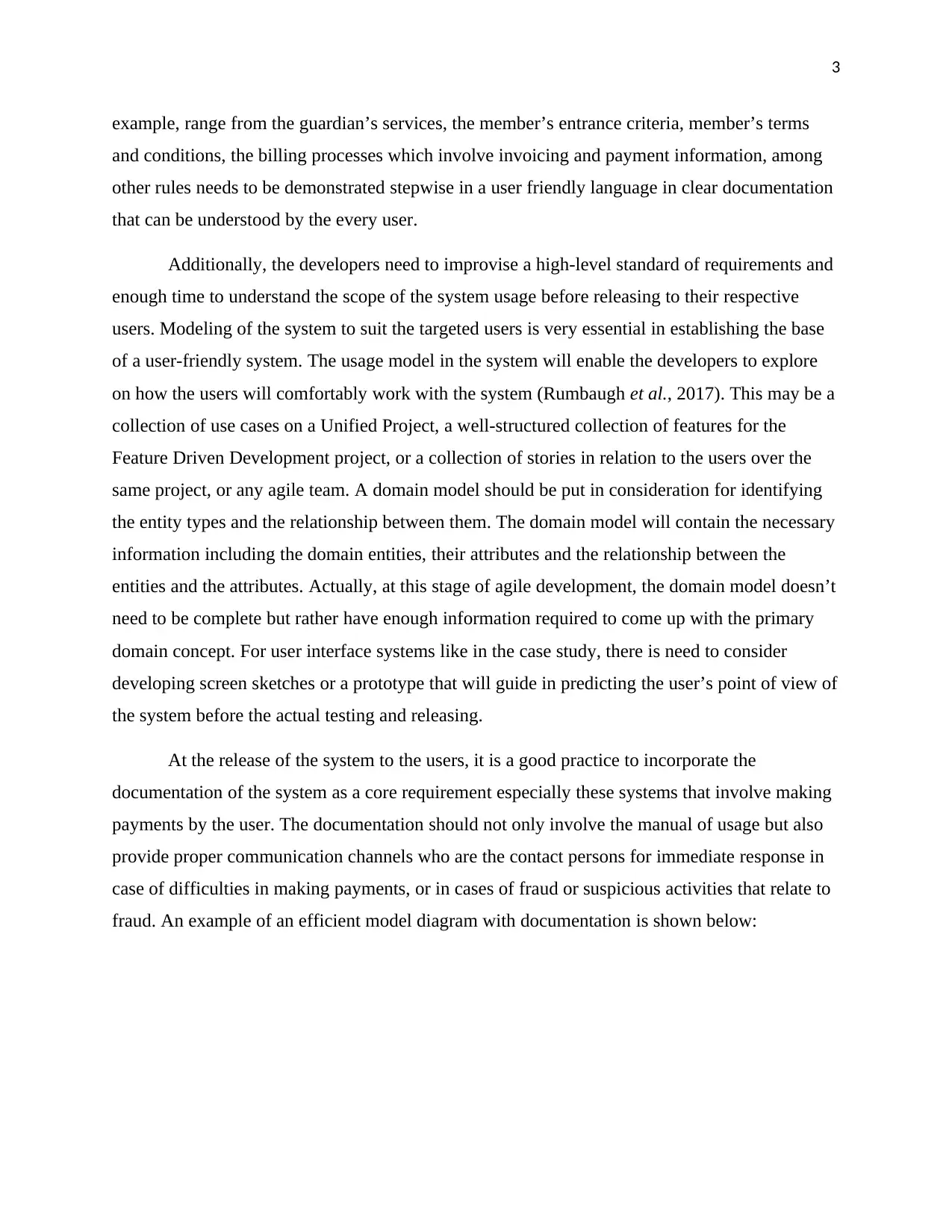
3
example, range from the guardian’s services, the member’s entrance criteria, member’s terms
and conditions, the billing processes which involve invoicing and payment information, among
other rules needs to be demonstrated stepwise in a user friendly language in clear documentation
that can be understood by the every user.
Additionally, the developers need to improvise a high-level standard of requirements and
enough time to understand the scope of the system usage before releasing to their respective
users. Modeling of the system to suit the targeted users is very essential in establishing the base
of a user-friendly system. The usage model in the system will enable the developers to explore
on how the users will comfortably work with the system (Rumbaugh et al., 2017). This may be a
collection of use cases on a Unified Project, a well-structured collection of features for the
Feature Driven Development project, or a collection of stories in relation to the users over the
same project, or any agile team. A domain model should be put in consideration for identifying
the entity types and the relationship between them. The domain model will contain the necessary
information including the domain entities, their attributes and the relationship between the
entities and the attributes. Actually, at this stage of agile development, the domain model doesn’t
need to be complete but rather have enough information required to come up with the primary
domain concept. For user interface systems like in the case study, there is need to consider
developing screen sketches or a prototype that will guide in predicting the user’s point of view of
the system before the actual testing and releasing.
At the release of the system to the users, it is a good practice to incorporate the
documentation of the system as a core requirement especially these systems that involve making
payments by the user. The documentation should not only involve the manual of usage but also
provide proper communication channels who are the contact persons for immediate response in
case of difficulties in making payments, or in cases of fraud or suspicious activities that relate to
fraud. An example of an efficient model diagram with documentation is shown below:
example, range from the guardian’s services, the member’s entrance criteria, member’s terms
and conditions, the billing processes which involve invoicing and payment information, among
other rules needs to be demonstrated stepwise in a user friendly language in clear documentation
that can be understood by the every user.
Additionally, the developers need to improvise a high-level standard of requirements and
enough time to understand the scope of the system usage before releasing to their respective
users. Modeling of the system to suit the targeted users is very essential in establishing the base
of a user-friendly system. The usage model in the system will enable the developers to explore
on how the users will comfortably work with the system (Rumbaugh et al., 2017). This may be a
collection of use cases on a Unified Project, a well-structured collection of features for the
Feature Driven Development project, or a collection of stories in relation to the users over the
same project, or any agile team. A domain model should be put in consideration for identifying
the entity types and the relationship between them. The domain model will contain the necessary
information including the domain entities, their attributes and the relationship between the
entities and the attributes. Actually, at this stage of agile development, the domain model doesn’t
need to be complete but rather have enough information required to come up with the primary
domain concept. For user interface systems like in the case study, there is need to consider
developing screen sketches or a prototype that will guide in predicting the user’s point of view of
the system before the actual testing and releasing.
At the release of the system to the users, it is a good practice to incorporate the
documentation of the system as a core requirement especially these systems that involve making
payments by the user. The documentation should not only involve the manual of usage but also
provide proper communication channels who are the contact persons for immediate response in
case of difficulties in making payments, or in cases of fraud or suspicious activities that relate to
fraud. An example of an efficient model diagram with documentation is shown below:
⊘ This is a preview!⊘
Do you want full access?
Subscribe today to unlock all pages.

Trusted by 1+ million students worldwide
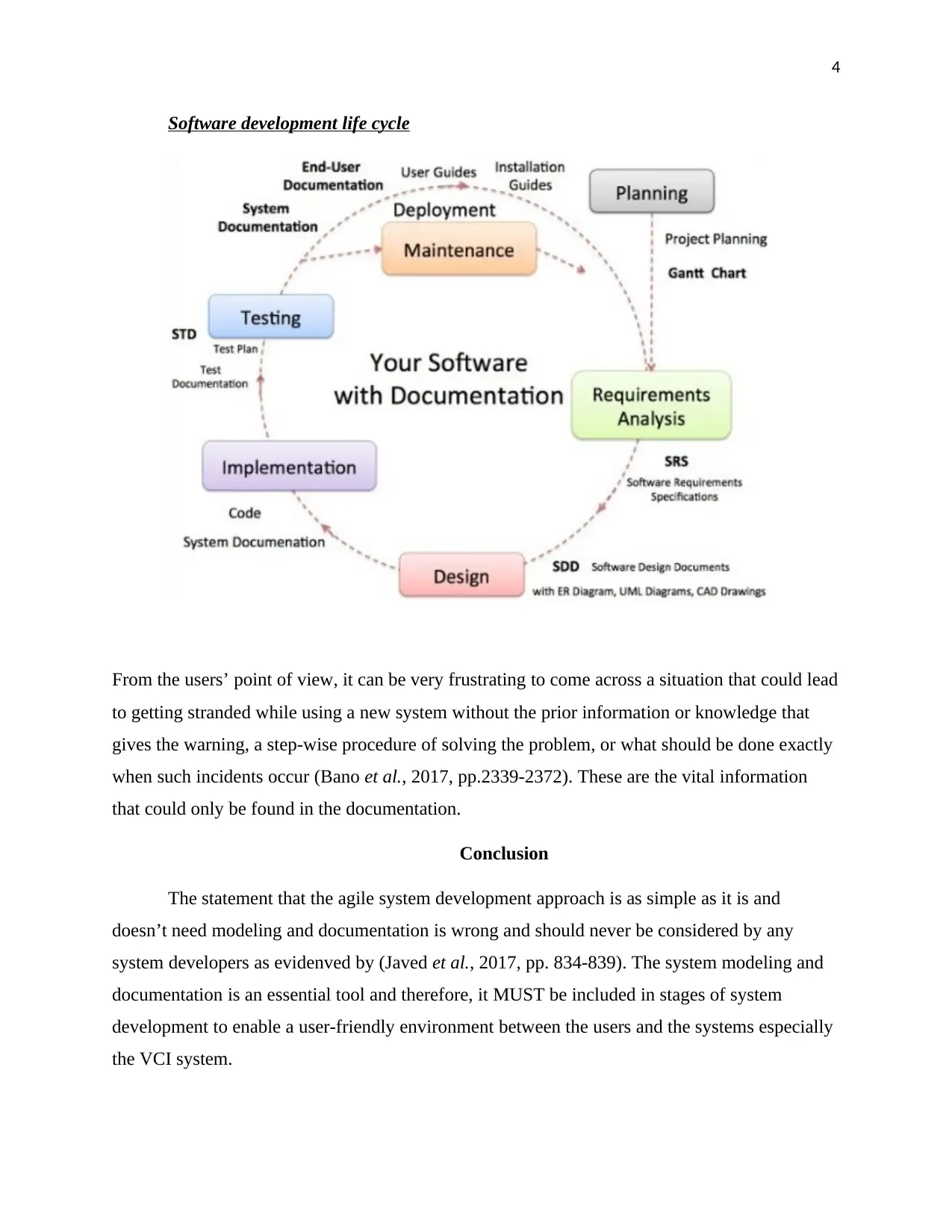
4
Software development life cycle
From the users’ point of view, it can be very frustrating to come across a situation that could lead
to getting stranded while using a new system without the prior information or knowledge that
gives the warning, a step-wise procedure of solving the problem, or what should be done exactly
when such incidents occur (Bano et al., 2017, pp.2339-2372). These are the vital information
that could only be found in the documentation.
Conclusion
The statement that the agile system development approach is as simple as it is and
doesn’t need modeling and documentation is wrong and should never be considered by any
system developers as evidenved by (Javed et al., 2017, pp. 834-839). The system modeling and
documentation is an essential tool and therefore, it MUST be included in stages of system
development to enable a user-friendly environment between the users and the systems especially
the VCI system.
Software development life cycle
From the users’ point of view, it can be very frustrating to come across a situation that could lead
to getting stranded while using a new system without the prior information or knowledge that
gives the warning, a step-wise procedure of solving the problem, or what should be done exactly
when such incidents occur (Bano et al., 2017, pp.2339-2372). These are the vital information
that could only be found in the documentation.
Conclusion
The statement that the agile system development approach is as simple as it is and
doesn’t need modeling and documentation is wrong and should never be considered by any
system developers as evidenved by (Javed et al., 2017, pp. 834-839). The system modeling and
documentation is an essential tool and therefore, it MUST be included in stages of system
development to enable a user-friendly environment between the users and the systems especially
the VCI system.
Paraphrase This Document
Need a fresh take? Get an instant paraphrase of this document with our AI Paraphraser
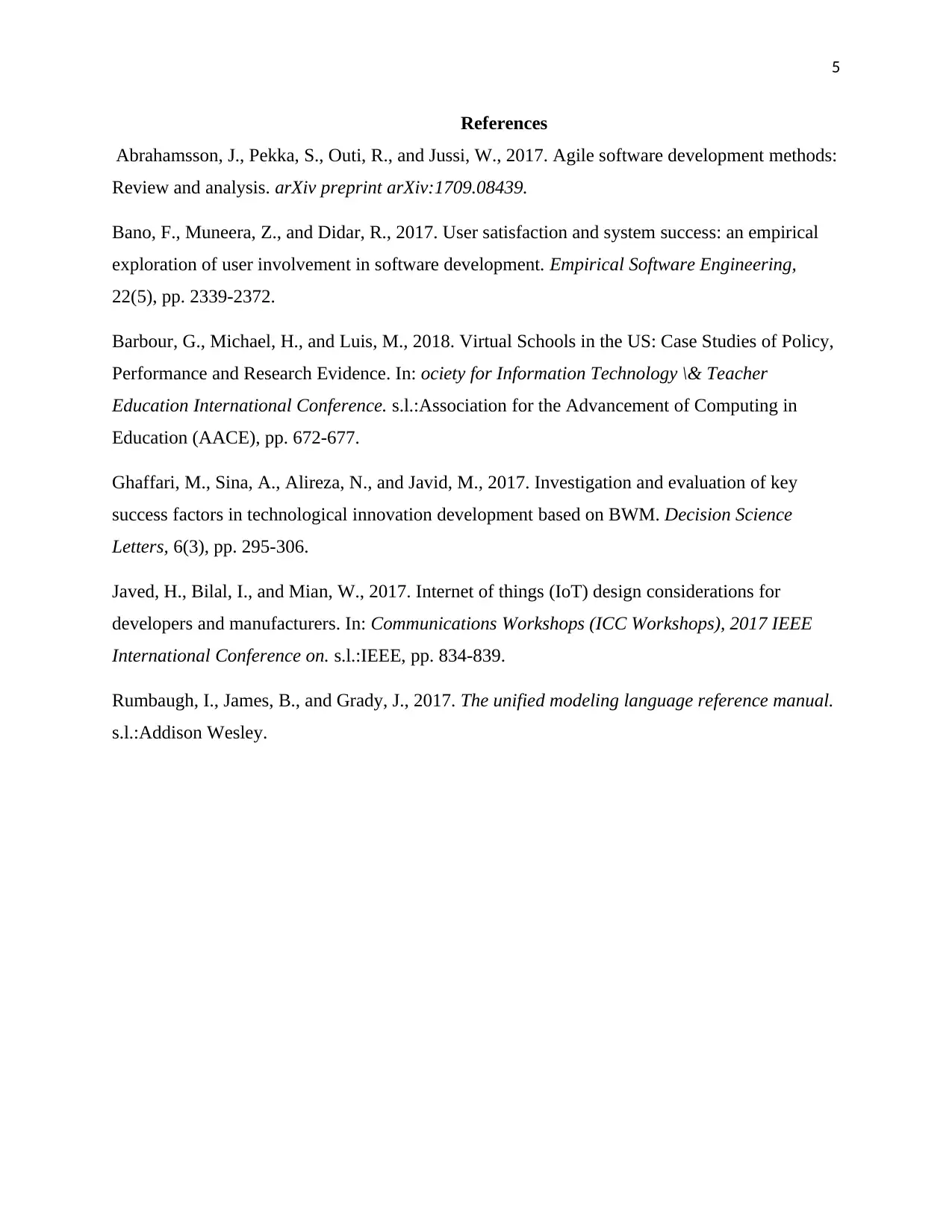
5
References
Abrahamsson, J., Pekka, S., Outi, R., and Jussi, W., 2017. Agile software development methods:
Review and analysis. arXiv preprint arXiv:1709.08439.
Bano, F., Muneera, Z., and Didar, R., 2017. User satisfaction and system success: an empirical
exploration of user involvement in software development. Empirical Software Engineering,
22(5), pp. 2339-2372.
Barbour, G., Michael, H., and Luis, M., 2018. Virtual Schools in the US: Case Studies of Policy,
Performance and Research Evidence. In: ociety for Information Technology \& Teacher
Education International Conference. s.l.:Association for the Advancement of Computing in
Education (AACE), pp. 672-677.
Ghaffari, M., Sina, A., Alireza, N., and Javid, M., 2017. Investigation and evaluation of key
success factors in technological innovation development based on BWM. Decision Science
Letters, 6(3), pp. 295-306.
Javed, H., Bilal, I., and Mian, W., 2017. Internet of things (IoT) design considerations for
developers and manufacturers. In: Communications Workshops (ICC Workshops), 2017 IEEE
International Conference on. s.l.:IEEE, pp. 834-839.
Rumbaugh, I., James, B., and Grady, J., 2017. The unified modeling language reference manual.
s.l.:Addison Wesley.
References
Abrahamsson, J., Pekka, S., Outi, R., and Jussi, W., 2017. Agile software development methods:
Review and analysis. arXiv preprint arXiv:1709.08439.
Bano, F., Muneera, Z., and Didar, R., 2017. User satisfaction and system success: an empirical
exploration of user involvement in software development. Empirical Software Engineering,
22(5), pp. 2339-2372.
Barbour, G., Michael, H., and Luis, M., 2018. Virtual Schools in the US: Case Studies of Policy,
Performance and Research Evidence. In: ociety for Information Technology \& Teacher
Education International Conference. s.l.:Association for the Advancement of Computing in
Education (AACE), pp. 672-677.
Ghaffari, M., Sina, A., Alireza, N., and Javid, M., 2017. Investigation and evaluation of key
success factors in technological innovation development based on BWM. Decision Science
Letters, 6(3), pp. 295-306.
Javed, H., Bilal, I., and Mian, W., 2017. Internet of things (IoT) design considerations for
developers and manufacturers. In: Communications Workshops (ICC Workshops), 2017 IEEE
International Conference on. s.l.:IEEE, pp. 834-839.
Rumbaugh, I., James, B., and Grady, J., 2017. The unified modeling language reference manual.
s.l.:Addison Wesley.
1 out of 5
Your All-in-One AI-Powered Toolkit for Academic Success.
+13062052269
info@desklib.com
Available 24*7 on WhatsApp / Email
![[object Object]](/_next/static/media/star-bottom.7253800d.svg)
Unlock your academic potential
Copyright © 2020–2025 A2Z Services. All Rights Reserved. Developed and managed by ZUCOL.
